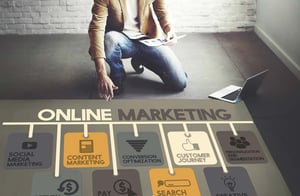Why Inbound Marketing is the Best Road for B2B Lead Generation
When it comes to inbound marketing, do you and your sales team really know how to find high-quality leads? Do you have a well-established and effective lead generation strategy that points to a relatively high sales conversion rate? Or perhaps you’re relatively new to the game, and you need clarification or a refresher to help you understand how inbound marketing works in the digital world? Keep reading for an overview of what inbound marketing is, and why it’s so essential for lead generation.
What is B2B Lead Generation and Inbound Marketing?
 Back in the day, outbound strategies such as the “cold call” used to be a key part of some companies’ lead generation techniques. The door-to-door salesman is the perfect example of this: If you demonstrated even some interest in their "coming back later," you were a lead, and they'd probably come back the following week, whether you were genuinely interested or not.
Back in the day, outbound strategies such as the “cold call” used to be a key part of some companies’ lead generation techniques. The door-to-door salesman is the perfect example of this: If you demonstrated even some interest in their "coming back later," you were a lead, and they'd probably come back the following week, whether you were genuinely interested or not.
Basically, leads are people who have shown some level of interest in your product or service. And when they are “inbound” – that is, coming to you, the interest is generally going to be more organic.
Leads may discover you through social networking and were then redirected to your landing page, where they signed up to be on a mailing list in exchange for their information. At this time, they would receive a free or inexpensive offering as a "thank you" for joining. As they are now on your mail list, they will likely be informed of your products and services after the fact via email marketing.
That is just one example of an inbound marketing technique that's popular in today's B2B and B2C digital marketplaces.
Inbound is About Choice
As you open this first step of communication with potential customers, your next task is to inform, educate, and engage them so that they understand precisely what you have to offer and choose to buy it.
Choosing to buy it is the key term, here; you cannot demand or force people to make a purchase. Because consumers and clients have so much choice in the digital age, it's very important that they warm up to you organically.
Though outbound marketing still has its place in some instances, in general, it just isn't as effective in the digital age. You can't make a sale and "push" someone to buy. Instead, you have to give them everything they need so that they choose to come to you time and time again, eventually making one or more purchases.
When people genuinely connect with your product or service, they will tell their friends, and that peer-to-peer advertising can go a long way. The point is that they're coming "in" instead of you going "out."
That is the basis of inbound marketing, and the primary way to find quality leads.
Why Do You Need to Go Inbound?
There are many benefits to inbound, and you should consider them as a crucial strategy for most of your digital marketing activities — here are a few.
Outbound No Longer Works
 Put simply, the internet is just too cluttered these days, which is why outbound doesn't tend to work as well as it did in the past.
Put simply, the internet is just too cluttered these days, which is why outbound doesn't tend to work as well as it did in the past.
Customers face information-overwhelm even when it comes to their personal email boxes, let alone social media. And this abundance is so prevalent that they don't tend to notice ads as much as they may have decades ago, when people were, for instance, immersed in a newspaper or their favourite television program.
Today, customers are more interested in simplifying, and they want to make purchases on their own terms.
This desire actually forces marketers to research their market deeply — they aren't just blindly putting out ads to anyone anymore. Now they must understand demographics and metrics to effectively reach their target audience.
So, they check out analytics on a regular basis and continually refine the parameters for success as they learn.
Content Marketing
When you use content marketing as your main inbound marketing technique, you establish yourself as an authority in your field, and thereby garner the respect and loyalty of customers, but only when you do it well.
There's so much content out in the world that you must make your own content stand out from the rest, and this means sharing information about your expertise.
If you are in the B2B world, this is even more pronounced, since your clients may technically be your competition, so you also have to give them something new and exciting to read.
That’s why developing valuable content like blog posts with a clear call to action that leads people to another valuable product is critical.
Warm Up and Measure Your Leads
Lead scoring is a way of ranking your contacts in such a way that shows how "warm" they are. It's a vital part of inbound marketing, and in the digital sphere when you may have hundreds or thousands of contacts, it can be a bit tricky without automated technology to help you.
This ranking system is essential for sales because it helps you determine when these leads are "ready" to be converted to customers – otherwise known as sales qualified leads (SQL).
 Pure and Simple Trust
Pure and Simple Trust
Brands are big these days, and so is convenience. People can get anything they want, anytime. As a result, they're constantly on the hunt for brands and products that they can trust.
Content marketing is the main way to get the word out about what your brand and company is about — not just what you do, but how you do it.
When you create valuable blogs and other visible content, this allows you to establish authority. The more influence you have, the more value you offer your audience, and thus more people will trust you.
It's Never a Wasted Effort
The reason why inbound has a strong ROI is that, when done well, it's a constant process of identifying the strongest leads and refining your marketing strategy. For the most part, efforts aren't going to waste. You won't have to invest tens of thousands in advertising, for instance, only to risk an ad failing to bring in an acceptable return.
Instead of investing in ads that might result in an audience of millions (but there's no telling), you can start with a slow, inexpensive strategy and build up and change it over time.
With inbound marketing, you will spend less time marketing erratically (outbound) and more time understanding and captivating your audience.
Table of contents
Share this
You May Also Like
These Related Stories

How B2B Companies Can Capitalize on Social Media Lead Generation

Maximizing B2B Lead Generation with HubSpot's Marketing Automation

